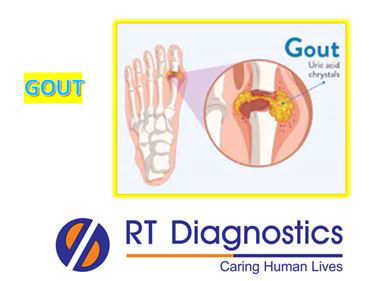Uric acid – Urine:
Why urine Uric Acid test?
CLINICAL INFORMATION
Uric Acid is synthesized from the nitrogen-containing compounds in the cells which are known as purines. Thus catabolism of purines yields uric acid that is excreted in urine and stools. This uric acid test is usually done for altered levels of uric acid in blood in certain pathologies. If too much accumulation of uric acid remains in the blood it leads to a condition known as hyperuricemia. This condition can lead to the formation of uric acid or urate crystals in the joints causing a pathology known as Gout (a form of very painful arthritis affecting the big toes due to accumulation of uric acid crystal deposition) and also these can accumulate in kidneys to form renal stones. This test is suggested in patients with symptoms of gout with intense pain and swelling around one or more joints (especially - in particular, affects the big toes but can also affect the joints of the ankles and feet, apart from toes) causing lingering discomfort, and signs of redness inflammation. This uric acid test evaluates the levels of uric acid in the blood, urine and other body fluids (eg. synovial fluid etc) and thus the test result helps to evaluate certain abnormal pathologies (abnormalities) related to uric acid. Moreover, this test also reflects the natural breakdown of cells (turn-over of cells – the destruction of old cells and replacing new cells) and also helps in detecting excess uric acid in conditions such as gout (often affecting the big toes), acute renal failure etc. Therefore this test helps in the prognosis (monitoring the treatment with uricosuric drugs for gout) of uric acid associated disorders. This test suggested during prognosis for monitoring chemotherapy, kidney stones etc.The uric acid blood test is used to detect diseases like gout (affecting their big toes), kidney diseases and/or patients undergoing chemotherapy or radiation therapy for cancer. Other pathologies associated with high uric acid include obesity, fasting, rapid weight loss, stress, strenuous exercise, liver and kidney pathologies, Lesch-Nyhan syndrome, cancer metastasis, rhabdomyolysis (breakdown of muscle fibres), atherosclerosis, myelo-proliferative and bone marrow disorders (bone marrow disorders), Fanconi syndrome, multiple myeloma, leukaemia, polycythemia, preeclampsia (pregnancy) etc. These levels can also get elevated on consuming a nucleoprotein rich diet, intake of red meat diet etc. Chronic untreated conditions with hyperuricemia can lead to complications like heart attack, stroke etc. While low levels of uric acid can be caused due to lead poisoning, chronic alcoholics, glomerulonephritis, multiple sclerosis, meningitis and other kidney diseases etc. Certain medicines may alter this test result namely aspirin or aspirin-containing medicines, cyclosporine, niacin, medicines used for Gout, NSAIDs, diuretics etc. Additional tests include Auto-immune diseases of the nucleus, nucleic acids (eg. ANA, pANCAetc), psoriasis etc. Other tests include tests for SLE, rheumatoid arthritis (RA), diseases associated with synovial fluid, imaging studies etc.

General Instructions:
Sample Requirement: Specimen - Urine Sample. Test Preparation: None.
NOTE - Sample for specimen collections may vary based on the patient’s condition/cases according to the patient’s presenting complaints/signs or symptoms:
SPECIMEN REQUIREMENT (Special or Rare Cases) - As instructed and guided by Physician / Clinician / Pathologist / as per Laboratory’s requirements, according to procedures and protocols.
This Multi-Specialty Clinical Referral Laboratory RT DIAGNOSTICS provides precise and accurate tests with an extensive range of testing services to the medical centres to help in the diagnosis and identification of pathology in the test specimens for infectious diseases and also to evaluate the function of organ systems of the patient. It prevents further complications and helps to stabilize and restore health to near normalcy at the earliest without delay.



